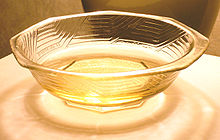


Mirin (味醂 or みりん, Japanese: [miɾiɴ]) is a type of rice wine and a common ingredient in Japanese cooking. It is similar to sake but with a lower alcohol content and higher sugar content.[1] The sugar content is a complex carbohydrate that forms naturally during the fermentation process; no sugars are added. The alcohol content is further lowered when the liquid is heated.
Three types of products are marketed as mirin. The first is hon mirin (literally: true mirin),[2] which contains about 14% alcohol and is produced by a 40 to 60 day mashing (saccharification) process.[3] The second is shio mirin (literally: salt mirin), which contains a minimum of 1.5% salt to prevent consumption in order to avoid alcohol tax.[4]
The third are mirin-like seasonings called shin mirin (literally: new mirin),[5]ormirin-fu chomiryo (literally: mirin-like seasoning),[6] which are substitutes not actually mirin.[7] They are blends of sweetener syrups, flavorings such as kōji extracts, and flavour enhancers.[3] They contain less than 1% alcohol.[3]
The term or trade name aji-mirin (literally: taste mirin) can mean various things, such as salt mirin,[8] synthetic mirin,[6]ormirin-like seasonings.[7]
In the Edo period, mirin was consumed as amazake.[9] O-toso, traditionally consumed for the Japanese New Year, can be made by soaking a spice mixture in mirin.[10]
In the Kansai style of cooking, mirin is briefly boiled before use, allowing some alcohol to evaporate. In the Kantō regional style, the mirin is used untreated. Kansai-style boiled mirin is called nikiri mirin (煮切り味醂)[11] (literally: thoroughly boiled mirin).

Mirin adds a bright touch to grilled or broiled fish or erases the fishy smell. A small amount is often used instead of sugar and soy sauce. It is sometimes used to accompany sushi.
Mirin is also an ingredient in other sauces:
{{cite book}}: CS1 maint: multiple names: authors list (link)
they fill the pan with about 500 bones of eel, and simmer it for 2 to 3 hours.
|
| |||||||||||
|---|---|---|---|---|---|---|---|---|---|---|---|
| Main dishes (Shushoku) |
| ||||||||||
| Side dishes (Okazu) |
| ||||||||||
| Beverages |
| ||||||||||
| Snacks / desserts/ Wagashi |
| ||||||||||
| Ingredients / condiments |
| ||||||||||
| Utensils |
| ||||||||||
| Lists |
| ||||||||||
| Fruits |
| ||||||||||
| Related |
| ||||||||||
| |||||||||||
| Authority control databases: National |
|
|---|